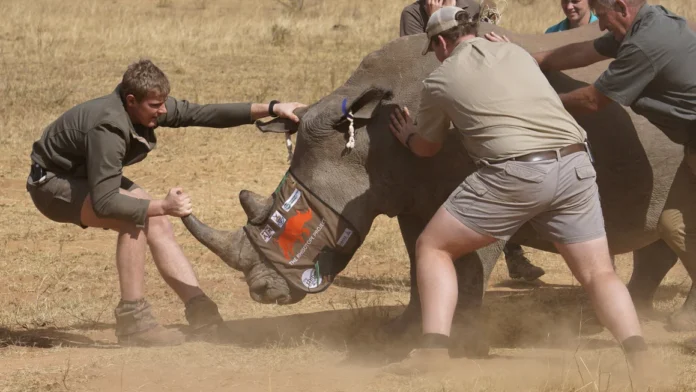Scientists are testing a novel technique to deter poachers targeting endangered rhinoceros for their prized horns. As part of a pilot study in South Africa, researchers have injected small, radioactive pellets into the horns of live rhinos. The goal is to make the horns radioactive so there is less demand for them on the black market.
About 20 rhinoceroses have been selected for the pilot study dubbed the Rhisotope Project. Among the tests is examining the rhinos’ blood to ensure the animals are not being harmed.
Arrie van Deventer is the founder and managing director of Rhino Orphanage, and he oversees the research animals in South Africa’s Waterberg Region.
“We’ve all been looking and trying to find the silver bullet to stop rhino poaching, and I think this could just be what we need to stop poaching in its tracks. It is a brilliant idea,” he said.
Six months ago, the orphanage staff helped scientists insert radioactive pellets into the horns of wild rhinos. Recently, South African and American scientists returned to take more blood samples from the research animals and measure the gamma rays emitted by the pellets.
According to Craig Marianno, a researcher from Texas A&M University, ensuring the animals are not harmed is the top priority.
“The radiation they’re getting would be almost like somebody traveling internationally on a plane overseas two or three times a year, so…it’s very, very low,” he said.
James Larkin, a researcher from the University of the Witwatersrand who leads the internationally funded program, studied the radiation dose being used in the study.
“I spent two and a half years developing computer models of the animals, carrying out tests, and comparing these with results from the International Commission on Radiation Protection, and our results compare extraordinarily favorably,” he said.
However, Larkin says the dose is still strong enough to set off radiation detectors at international borders, making it more difficult to smuggle the horns.
Rhinos in Africa have long been targeted by poaching syndicates that feed the black market demand for rhino horns in Asia, pushing the world’s five rhinoceros species toward extinction.
In parts of Asia, rhino horns are believed to have medicinal benefits, although there is no scientific evidence to support that claim.
Larkin says that if finally approved, the technology would be more cost-effective than the current strategy of discouraging poaching by dehorning rhinos every two years, as rhino horns grow continuously.
For van Deventer, the rhino poaching situation is dire, so he is eager for the project’s results.
Scientists hope blood tests will confirm that the animals are still healthy. Test results are expected in about two months. If funding permits, the technology could be offered to rhino owners by the end of this year.



















